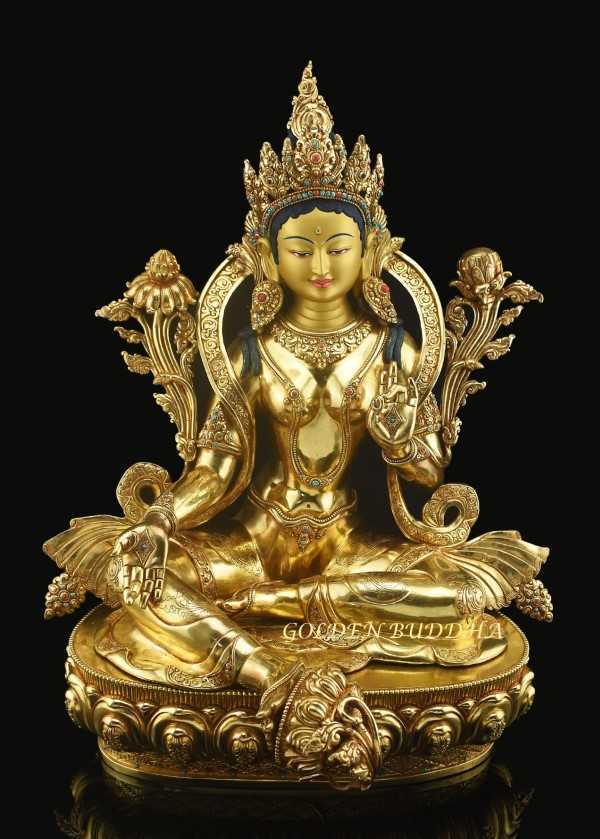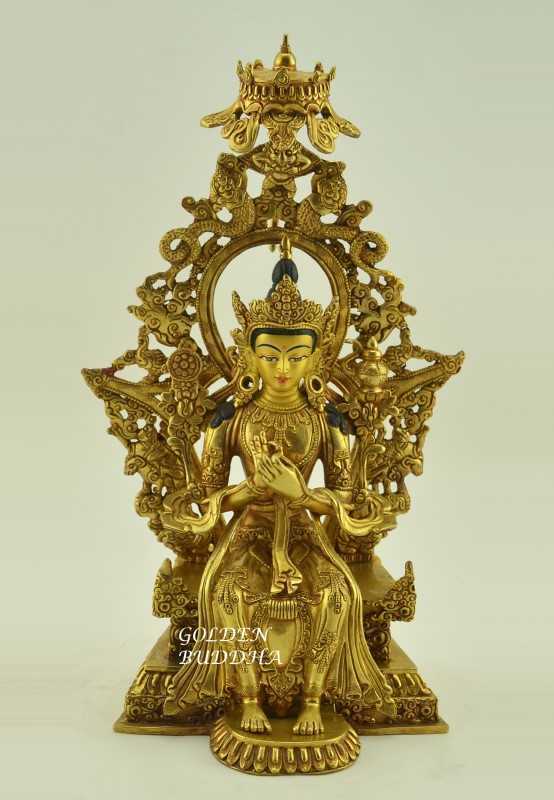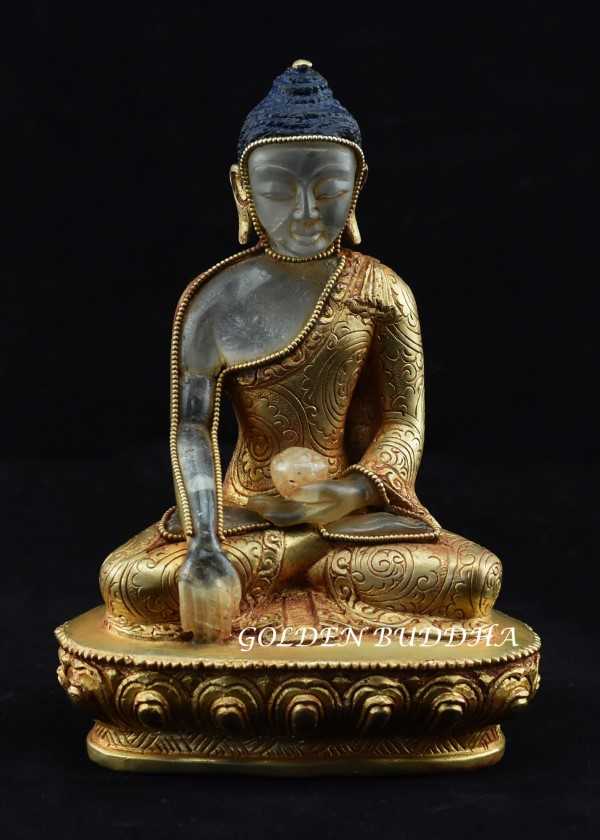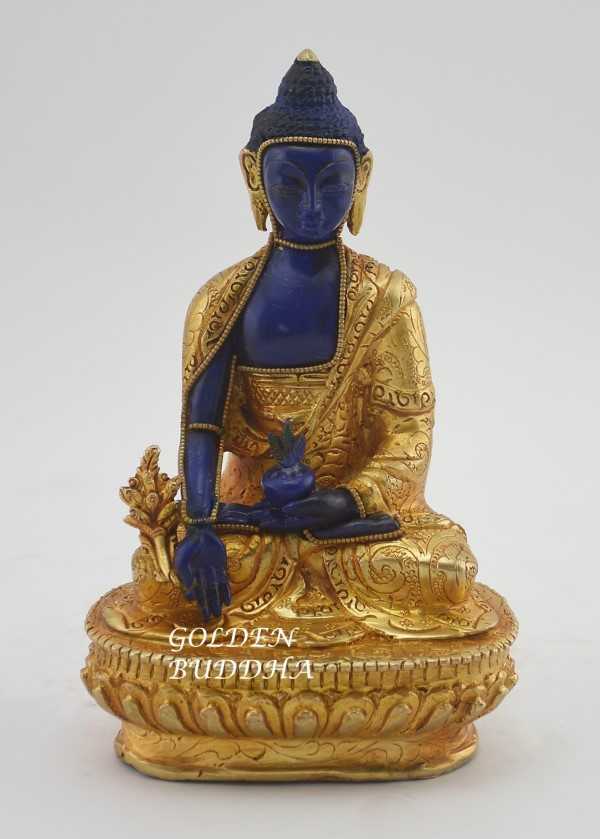All Buddha statues are displaying some kind of Buddha poses or mudras. Indeed, it is often the case that a Buddhist deity will display more than one pose to reveal more than one Buddha statue meaning.
Rest assured, Buddha statues always reveal Buddha statue meanings using their Buddha poses. In addition, learn the story behind the most important Buddha poses. The inspirational story will provide guidance and inspiration on multiple levels.
Here you will find most common Buddhist mudras and Buddha poses. Learning to recognize the attributes of different Buddha statues will tell you everything you need to know!
Buddha Poses and Meanings:
- Abhaya Mudra (Protection)
- Dharmachakra Mudra (Teaching)
- Dhyana Mudra (Meditation)
- Bhumisparsha Mudra (Enlightenment)
- Varada Mudra (Gift Giving)
- Vitarka Mudra (Debate)
- Reclining Buddha (Parinirvana)
- Standing Buddha Statue
- Laughing Buddha (Budai)
“Abhaya Mudra” Buddha Statue Meaning
Gautama Buddha statues (historical Buddha) always depict the Abhaya “Protection” mudra with the flat right hand. To further clarify, the Buddha displays the Abhaya “Protection” mudra with a the palm of his right hand flat in front of the chest facing forward away from the body.
In addition, when the Buddha displays Abhaya “Protection” mudra he is almost always displaying a second mudra with his left hand. His left hand is always in Dhyana “meditation” mudra usually with the alms bowl of a Buddhist monk resting in the palm.
Furthermore, if your Buddha is displaying Abhaya mudra with the right hand, the true identity of the statue is almost certainly the historical Buddha also known as Gautama Buddha or Shakyamuni Buddha.
Although there are some isolated exceptions with more complex deities such as Amoghasiddhi who uses the Abhaya mudra in the same manner as historical Buddha. However, their statues are of the same design. See below.
Protection Buddha Statue
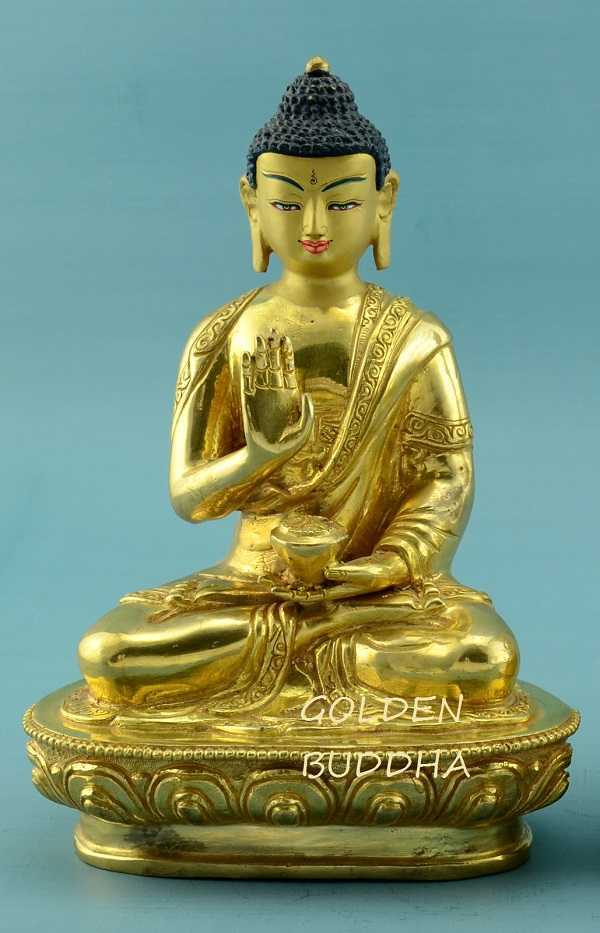
Common Variations of Abhaya Mudra
Other Buddhas and Bodhisattvas sometimes portray variations of the Abhaya mudra with their left hand. If so, the deity is often holding something in the same hand.
For example, the Green Tara statue below holds the stem of a lotus flower between the index finger and thumb while expressing the Abhaya mudra.
Indeed, devotees of the Buddhist deity “Tara” often seek her protection from fear and the eight obscurations. As a result, a female Buddha statue using this mudra with a raised left hand is very often Green Tara or it could also be White Tara.
Green Tara Uses Abhaya Mudra
A protection Buddha statue can be seated, standing or walking while expressing the Abhaya mudra. This mudra projects the Buddha statue meaning of protection, fearlessness and overcoming.
Protection Buddha statues presenting the Abhaya mudra are very common in Buddhist art and they are often using different variations as explained above. This is because it encourages unwavering faith in the Dharma which is a fundamental element of Buddhism.
The Origin of the Abhaya Mudra
Buddhist folklore reveals the origin of the protection Buddha statue meaning. This important event occurred during the lifetime of Shakyamuni Buddha.
In ancient India, one afternoon the Buddha was walking in the “Elephant Forest” leading a group of people. An elephant emerged through the trees in front of them and began charging towards them.
However, the Buddha fearlessly stood his ground and raised his right hand to pacify the elephant by displaying the Abhaya “Protection” mudra. As a result, the elephant stopped charging and disappeared back into the forest.
The calmness and faith of the Buddha had saved many lives, including his own. Therefore, this Buddha hand symbol meaning is used to inspire fearlessness, faith and perseverance in devotees.
“Dharmachakra Mudra” Buddha Statue Meaning
Dharmachakra mudra literally means the “Wheel of Dharma”. The spinning of the Dharma Wheel is a metaphor for the inception of the Buddha’s Dharma teachings during this time period.
The spinning wheel symbolizes that the Buddha had rediscovered the Dharma and shared the Dharma teachings with sentient life. Therefore, the Buddha displays the mudra at chest level because the Buddhist teachings come straight from the Buddha’s heart.
Furthermore, the Dharmachakra mudra is displayed with both hands.
- The right hand is at chest level and the palm facing outward with the index finger touching the thumb.
- The left hand is turned inward and the index finger and thumb of the left hand join to touch the circle.
“Spinning the Wheel of Dharma” Mudra
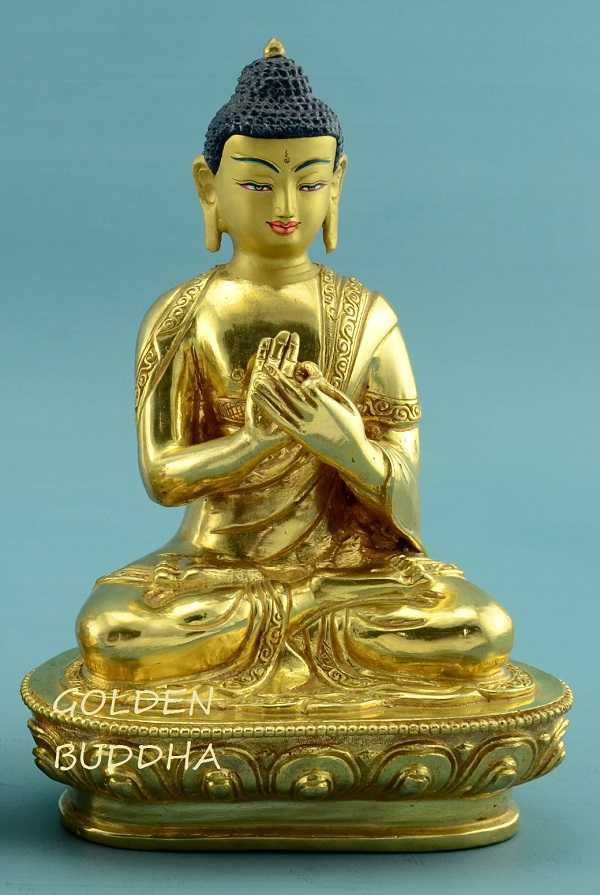
Significance of Dharmachakra Mudra
This is a very significant Buddhist mudra because it represents the inception of Buddhism during our time period. The Dharmachakra is depicted by what is known as a “Sammasambuddha”.
This type of Buddha discovered Buddhism on their own without following the teachings of another Buddha. Additionally, they chose to share the Dharma teachings with other sentient beings.
The appearance of a Sammasambuddha is few and far between. As a result not many of them are known to us. However, the ones we are aware of are very significant in Buddhist history (and future).
Examples of the Sammasambuddha are the Buddha of our time “Shakyamuni”, the Buddha of the past “Dipankara”, the Buddha of the future “Maitreya” and Primordial Buddha “Vairocana”.
The guru Tsongkhapa who is the founder of the Gelug school of Tibetan Buddhism is an exception. His statues often portray him displaying the Dharmachakra Mudra.
The Buddha’s First Sermon at Deer Park
The Historical Buddha delivered his first sermon to 5 companions after he achieved enlightenment. Additionally, thousands of Devas and Brahmas descended from the Buddhist heavens to attend.
This significant event which set the Dharma Wheel in motion occurred at the Deer Park in Sarnath, India. It is during the Deer Park sermon that the Buddha first revealed the Dharma teachings.
At the sermon, the Buddha set the “Wheel of Dharma” in motion by revealing the Dharma to sentient life.
This Buddha statue meaning carries great significance because it symbolizes the inception of Buddhism in our time. As a result, Dharmachakra mudra is the most original of all the Buddha poses.
“Dhyana Mudra” Buddha Statue Meaning
The Historical Buddha was using the Dhyana “Meditation” mudra as he obtained supreme enlightenment while he was meditating under the Bodhi tree. Therefore, statues depicting meditating Buddhas and Bodhisattvas always display the Dhyana mudra.
For example, both Gautama Buddha and also Amitabha Buddha statues often display Dhyana Meditation Mudra. However, the mudra is not exclusive for Buddhist deities.
Indeed, lay Buddhist practitioners and monks use the Dhyana Mudra while they are practicing their daily meditation.
How to Perform the Dhyana Meditation Mudra
Dhyana mudra is always depicted in seated position. Buddha statues use the seated pose called double lotus pose. However, simply having your legs crossed while seated on the floor will suffice.
Next, the back of the right hand is resting on the palm of the left hand and both hands are resting flat in the lap. Additionally, the top of the thumbs join together to form a small triangle.
The symbolism of the triangle is very important. Buddhists believe that the triangle symbolizes the unity of the triple gem – the Buddha, Dharma and the Sangha.
Furthermore, the triangle holds a “mystic fire” inside that will consume all defilements (impurities). As a result, concentration is strong during meditation practice and the mind remains undisturbed.
Dhyana Mudra with Alms Bowl
During the final days before the Buddha would obtain enlightenment, a rich woman saw him meditating under the Bodhi tree and mistook him for a tree deity. She wished to make an offering to the deity and placed a rice bowl made of pure gold in the palm of the Buddha’s right hand.
However, the Buddha took the rice out of the bowl and cast the golden bowl into the river. Additionally, he separated the rice into portions, each portion representing one day until he would reach supreme enlightenment.
The prophecy of the Buddha came to pass when he became fully enlightened. So Dhyana Mudra is often displayed by other Buddhas and Bodhisattvas while holding the alms bowl.
Furthermore, the alms bowl of a Buddhist monk has very significant meaning in Buddhism. The bowl represents renunciation of the material world and all of its comforts. Buddhists would gladly trade all the wealth, fame and pleasures in the world for the Dharma teachings.
Last but not least, devotees believe that the bowl symbolically holds the three nectars that eliminate the three poisons of greed, hatred and delusion.
Dhyana Mudra with Alms Bowl
Variations of the Dhyana Mudra
As alluded to above, sometimes Buddha statues depict the Dhyana mudra with the left hand only, such as when the Buddha is performing a second mudra with the right hand.
For example, when Shakyamuni Buddha performs the primary mudra with the right hand, he uses his left hand for Dhyana mudra. Nonetheless, the Dhyana mudra meaning remains the same.
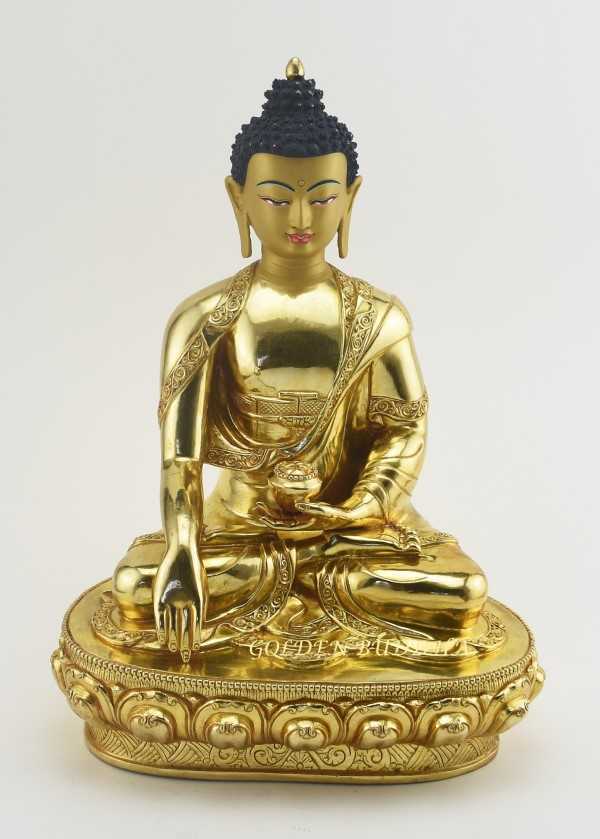
“Bhumisparsha Mudra” Buddha Statue Meaning
As the Buddha was on the verge of supreme enlightenment while meditating under the Bodhi tree, a powerful demon called Mara appeared. The demon tried to dissuade him from his goal with temptations of worldly pleasures and vast wealth.
However, the Buddha was not discouraged and he used meditation to strengthen his resolve. After meditating all night he was able to fight off the evil temptations of Mara and achieve supreme enlightenment.
At the moment of Mara’s vanquishment, the Buddha called on the earth goddess to witness his triumph by performing the Bhumisparsha “Earth Touching” mudra.
As a result, the meaning of the Bhumisparsha mudra is the triumph of the Dharma over the inner demons of earthly temptation. The earth goddess responded to his call and she rung out her hair and created a flood which washed away the demon Mara.
How to Display Bhumisparsha Mudra
The historical Buddha summoned the earth goddess by lightly touching the ground with the middle finger of his right hand. Additionally, the Buddha displayed the mudra while seated in full lotus pose under the Bodhi tree.
- The Buddha’s right hand is stretched over the right knee with the palm facing inwards while the middle finger is lightly touching the ground.
- The left hand is flat in the lap palm facing up with the alms bowl resting in the palm.
Because of its strong affiliation with Shakyamuni Buddha, this mudra is mostly exclusive to him. Additionally, the Buddha is always seated in full lotus pose while displaying Bhumisparsha mudra.
“Varada Mudra” Buddha Statue Meaning
Buddhas and Bodhisattvas use the Varada “Boon Granting” mudra to express the granting of a boon such as knowledge, medicine or compassion. As a result, the Varada mudra meaning encourages common Buddhists to engage in unselfish acts and follow the Dharma path.
The path to becoming a fully enlightened Buddha is indeed very long. Many Buddhas have lived thousands of Bodhisattva lifetimes during which they have accrued large amounts of merit from practicing generosity and unselfish behavior. The Varada mudra is a gesture that pays tribute to these acts of generosity.
These notable acts of generosity include renunciation and vows which are not uncommon in Buddhist history. For example, Buddhist deities who have fulfilled tremendous vows of generosity include Shakyamuni Buddha, Manjushri, Amitabha, Tara and Medicine Buddha.
Shakyamuni Buddha performed one of the greatest acts of generosity when he renounced his kingdom and inheritance. Additionally, the Buddha would discover the Dharma on his own and show sentient life the path to enlightenment.
How to Display Varada Mudra
Buddha statues usually depict the Varada mudra when seated by stretching the right hand over the right knee. Additionally, the right hand is flat and the palm is facing forwards away from the body.
The Buddha can display the Varada mudra while seated, standing or walking. Since Varada mudra is displayed with only one hand the deity is commonly displaying a second mudra with the other hand.
Medicine Buddha (Bhaisajyaguru) is another deity that often displays the Dhyana mudra. The Medicine Buddha uses the mudra to signify granting the gift of medicine to sentient life.
Symbolically, the Medicine Buddha holds a sprig of the myrobalan plant in between the thumb and forefinger of his right hand while displaying the mudra.
The myrobalan plant is an ancient herbal remedy that is still effectively used today. It is recommended to treat disorders such as skin disease, infection, and eye disorders.
Medicine Buddha Varada Mudra
“Vitarka Mudra” Buddha Statue Meaning
The Vitarka mudra meaning emphasizes the importance of teaching, discussion and intellectual debate. Certainly, the triumph of light over darkness requires the complete subjugation of ignorance. Therefore, discussion and intellectual debate are important tools that will prevent individuals from turning away from the Buddha’s teachings.
How to Display Vitarka Mudra
The palm of the right hand is held chest high facing outwards with the index finger touching the thumb forming a circle. The circle symbolizes the constant flow of energy signifying that there is no beginning or end, only perfection.
Also, the back of the left hand is flat in the lap with palm facing upwards. Usually the alms bowl of a Buddhist monk is in the flat of the palm and the Buddha sits in full lotus pose.
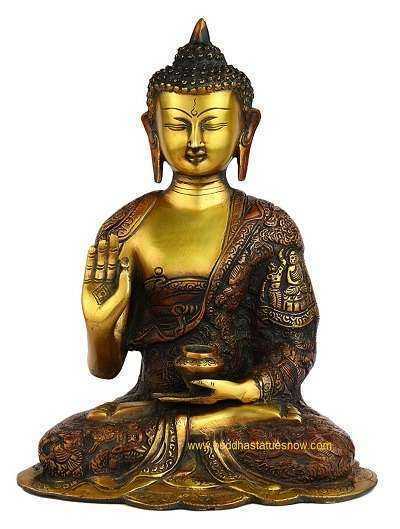
The Origin of the Vitarka Mudra
While the Buddha was still walking the earth and teaching the Dharma he initially prohibited his monks from engaging in debates. However, as Buddhism developed a large following it began to draw a lot of attention from laymen and intellectuals alike. Therefore, the Buddha softened his approach and he began to engage in public debates.
Indeed, the Buddha was a very gifted public speaker who effectively defended the Dharma against anyone that challenged him. As a result, Dharma teachings of the Buddha were accepted throughout Asia and worldwide by over 500 million Buddhists.
Reclining Buddha Statue Meaning
Reclining Buddha statues are not actually depicting a Buddhist mudra. This is in contrast with standing, walking or seated Buddha statues that are always using a mudra.
Instead, the reclining Buddha is seen lying on his right side. Additionally, the reclining Buddha statue uses its right hand to support his head. The flat right hand is placed under the head on a pillow or his hand is propped up on his elbow supporting the head.

Reclining Buddha Entering Parinirvana
The reclining Buddha statue meaning is very significant in the teachings of Buddhism. This is because the reclining Buddha statue depicts the historical Buddha lying on his right side in the last few moments of his life in the earthly realm. The Buddha is entering a condition called Parinirvana.
Parinirvana is experienced by an enlightened being at the end of their earthly life if they achieved supreme enlightenment during that lifetime. The state of Parinirvana means the Buddha has ended the cycle of rebirth and is being released from the cycle of samsara.
Standing Buddha Statue Meaning
Identification of the Standing Buddha pose is quite simple, because the Buddha is either standing or walking. Similar to other Buddha poses, the hand gestures and symbols will reveal the Standing Buddha statue meaning.
The most common Buddhist mudras used by a standing Buddha statue are the Varada and Abhaya mudras. Therefore, the meaning of standing Buddhas is often to inspire devotees with generosity and fearlessness.
The historical Buddha often used the standing Buddha posture after he obtained enlightenment. Additionally, it is common for standing Buddha statues to display the same mudra with both hands instead of only one.

Laughing Buddha Statue Meaning
Since the Laughing Buddha statue is so ubiquitous in East Asia (especially China), non Buddhists often confuse him with the historical Buddha. However, laughing Buddha poses and meanings are completely different in many ways – especially their physical attributes.
So when you see a fat laughing Buddha statue, it is “Budai” and he is unique to Chinese Buddhism.
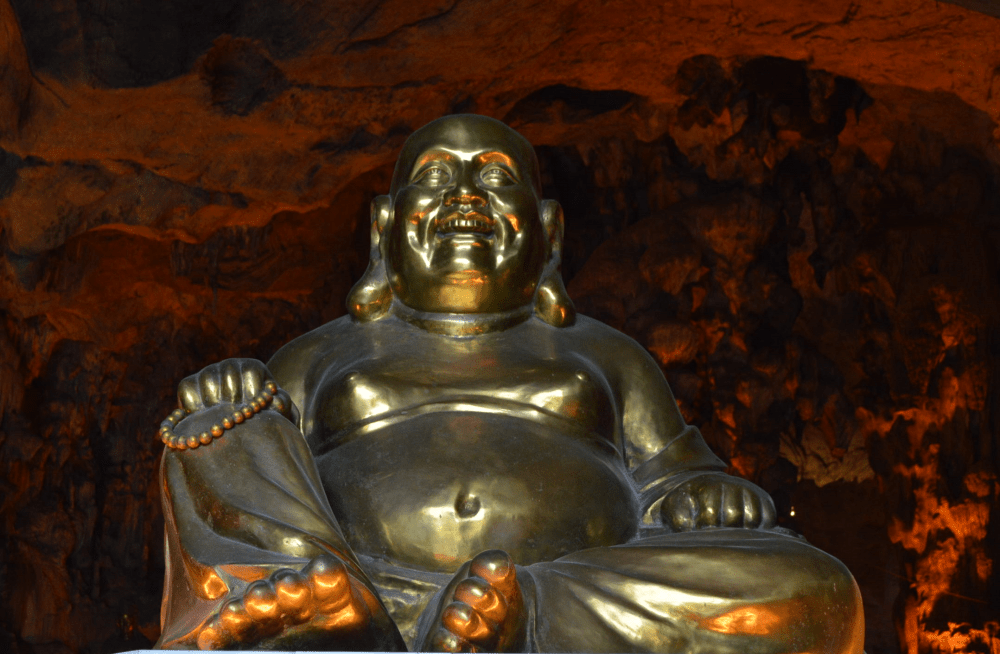
The Origin of Laughing Buddha
Laughing Buddha is a very popular Chinese deity who is also known as “Fat Buddha” or “Budai”. However, the character of a Laughing Buddha statue is actually based on a real life Chinese monk who lived during the 10th century ACE.
The name Budai translates as “cloth sack” in Chinese. Indeed, Laughing Buddha was always holding a cloth sack over his shoulder filled with his few possessions.
The Laughing Buddha statue meaning includes bringing wealth and prosperity to devotees. Although it seems a bit silly, devotees believe that rubbing his belly will bring you luck.
Furthermore, a Laughing Buddha statue is often depicted with small children as a symbol of prosperity. Last but not least, the Laughing Buddha statue meaning defines him as a person of good and loving character.


